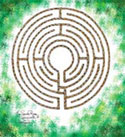The Prayer Labyrinth at EMU
 Students and visitors to EMU now have another way to pray and meditate on God. A labyrinth has been built on the
hill on the west side of EMU’s campus close to the seminary building. To reach it
go up the hill to the right of the seminary building toward the gazebo. The labyrinth
is above and to the right of the gazebo about 50 yards.
Students and visitors to EMU now have another way to pray and meditate on God. A labyrinth has been built on the
hill on the west side of EMU’s campus close to the seminary building. To reach it
go up the hill to the right of the seminary building toward the gazebo. The labyrinth
is above and to the right of the gazebo about 50 yards.
What is a Labyrinth?
A labyrinth is not a maze. In a labyrinth there is a clear path in and out. The labyrinth will assist students and campus visitors in Christian meditation and prayer. In the Middle Ages the labyrinths were used as a way for people to participate in a pilgrimage without the expense or time required in actually going to another place. Labyrinths were created on the floors of cathedrals to help draw people into meditation.
The labyrinth is a pre-Christian symbol, like adorning an evergreen tree with lights at Christmas or the symbol of the cross. Like these and other symbols, Christians have adopted and embraced the symbol of the labyrinth and in effect, have redeemed and baptized it for Christian use. Like most symbols it is primarily the orientation of the user, and not the symbol itself, that dictates whether it is used for harm or good.
The labyrinth at EMU is intended for Christian use. To make that clear we have created a cross in the center out of red river rock. As we walk toward the center, and the cross, we know and are known by Jesus, and we are reminded to center our life on God and God’s purposes. As we walk out again toward the edge, we are mindful of following Jesus in our life in the world.
How is a Labyrinth Used?
Lea Goode-Harris of California created the Santa Rosa design which EMU used for its labyrinth. A labyrinth helps direct one’s focus toward God. Unlike a maze, which has dead ends and the possibility of getting lost, a labyrinth has a clear path, but it sometimes takes unexpected twists and turns. In this way it resembles the journey of life.
Prayer with a labyrinth has three movements.
- As one moves toward the center of the labyrinth the person focuses on letting go of worldly attachments or coming to God with a question.
- At the center, the person comes to the center of his or her relationship with God. One may linger in the center of the labyrinth, spending time reflecting on one’s relationship with God and praying.
- Eventually, however, the need returns to move out into the world again. As the pilgrim leaves, she or he walks with Jesus back into places of ministry as a renewed person.
Here is another way to use the labyrinth
More Resources on Labyrinths
More resources on labyrinths and their uses are available in the Congregational Resource Center in the Seminary building. Below are a few websites that might guide you in learning more about labyrinths.
- https://gracecathedral.org/our-labyrinths/ This site describes the labyrinths at Grace Cathedral. There are several articles from this page that further explain the use and history of the labyrinth.
- http://www.labyrinth-enterprises.com/12reasons.html This site gives 12 reasons for churches to have labyrinths.
The Labyrinth at EMS
The EMU labyrinth is in the Santa Rosa design created by Lea Goode-Harris. Construction of the labyrinth itself was funded by the Theological Exploration of Vocation grant from the Lilly foundation; and funding for a retaining wall and landscaping was provided by private donors.


